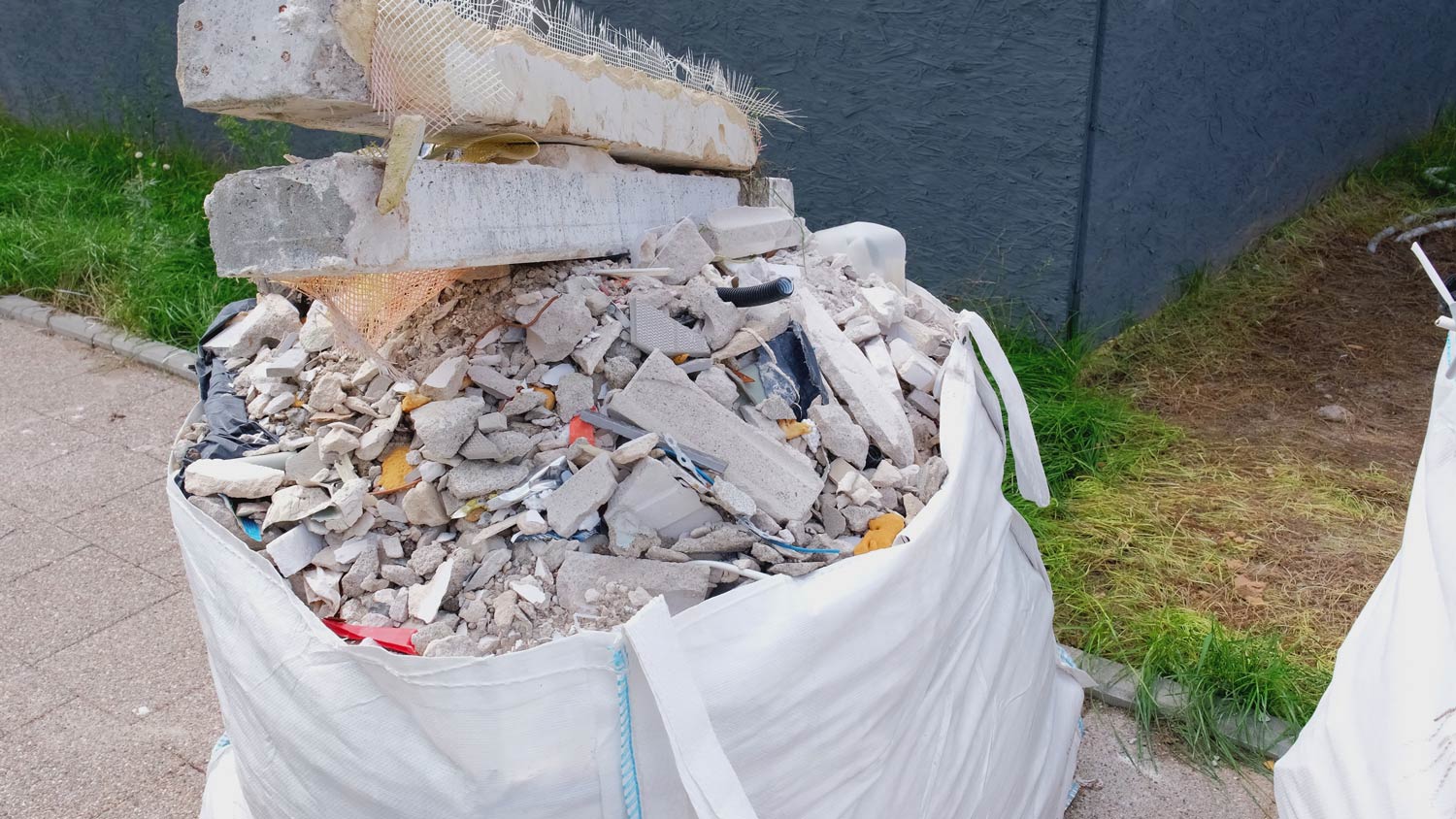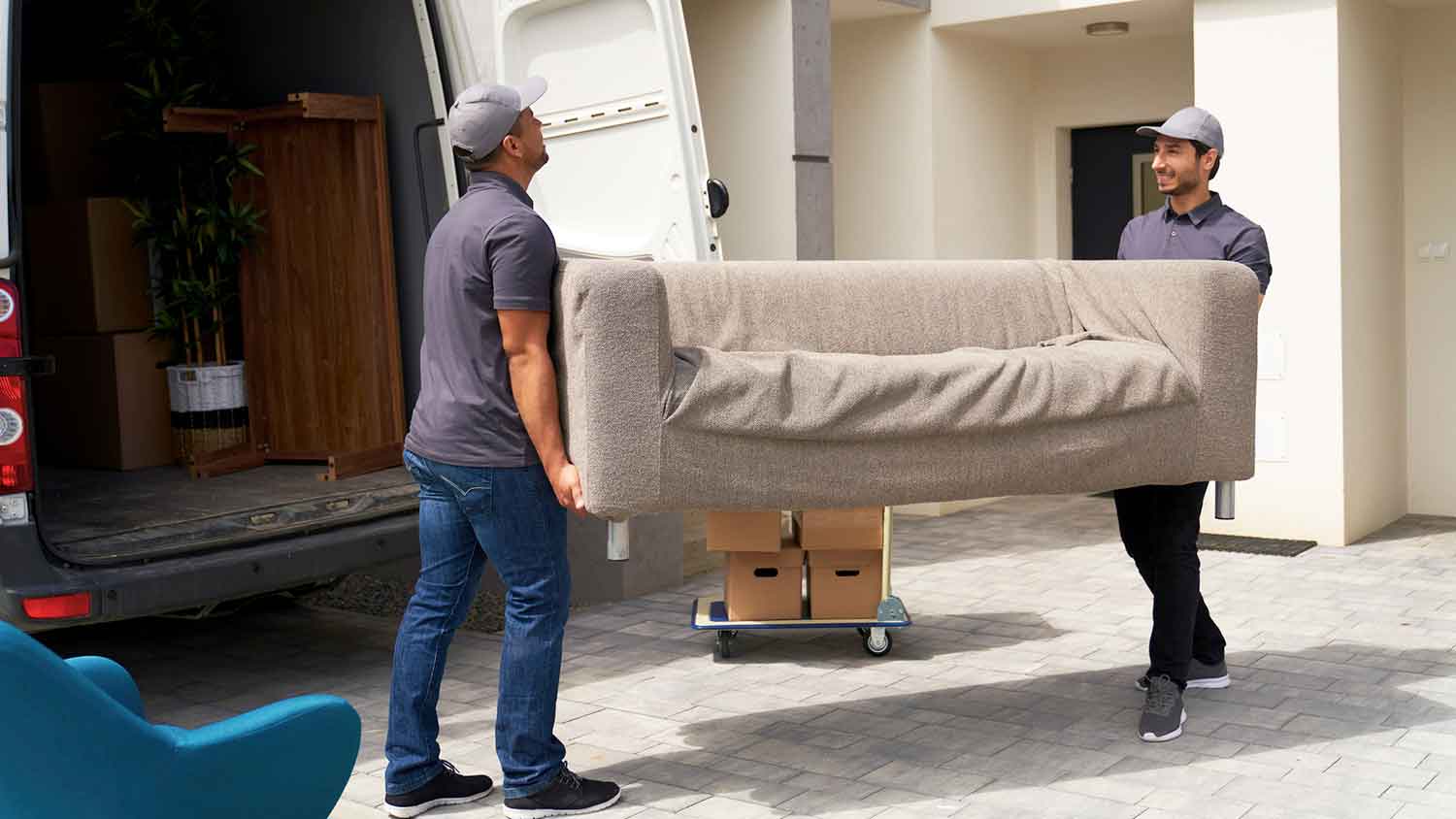How to Dispose of Concrete 5 Ways
Grab your jackhammer and get to work disposing of your old concrete slab


The only thing harder than concrete is getting rid of it. Whether you’ve just finished rebuilding your patio or demolishing your old walkway, when the time comes to remove the old, broken-up concrete, it’s important you do it correctly. In this article, you’ll weigh the pros and cons of five of the most common solutions for how to dispose of concrete so you can decide which is right for your project.
Why It Is Important to Dispose of Concrete Properly
According to the Environmental Protection Agency, construction and demolition materials like concrete are a surprisingly significant source of waste in the U.S. It takes a ton of resources and energy to produce new concrete—not to mention the CO2 emissions—and when you toss your concrete in the trash, it’ll end up in a landfill instead of being recycled into new material, resulting in double the waste. Taking the time to dispose of concrete appropriately can help create more jobs, keep landfills clear of debris, potentially offset the environmental impact of producing new materials, and create recycled concrete products that are less expensive to buy.
Signs It’s Time to Replace Your Concrete
How long concrete lasts depends on a few factors, like where it’s installed, how it’s mixed, and the weather in your area.
Concrete poured in Kansas, for example, will likely break down faster than concrete in sunny Florida with predictable year-round weather. You can expect most concrete sidewalks, driveways, or patio slabs to last about 30 years before they need to be replaced.
A few telltale signs you need to remove your old concrete and replace it with new concrete mix include:
Your concrete is starting to sink.
Multiple large cracks are forming.
You start to see large potholes.
The surface is drastically uneven, and water starts pooling in places.
Tips for Breaking Up Concrete for Disposal
Unless you have superhuman strength, you’ll need some big tools to help break the concrete down into more manageable chunks to dispose of it. Here are a few tips for how to remove concrete and dispose of it on your own:
Get a jackhammer. This will be the best tool for the job, especially if the slab is more than 3 inches thick. It’ll cost you about $95 per day to rent from a home improvement store.
Wash your concrete. Most recycling centers require you wash the concrete before you dispose of it so you don’t mix any waste or other materials.
Loosen the soil under the concrete. Digging up the soil below will make prying and removing easier.
Work from the outside in. Start about 6 inches away from the edge of your concrete, working your way in.
Wear protective gear. Don construction glasses and gloves to protect yourself from flying debris. You can also cover the slab with plastic sheeting to protect your windows or vehicles from it.
Prepare for mesh and rebar. Some materials like mesh and rebar are likely hiding beneath your concrete slab, so don’t be surprised if you run into them.
5 Ways to Dispose of Concrete

There are several different methods to consider when figuring out the best way to dispose of concrete. Depending on your skill level, available tools and vehicles, and your time, one or more of these options may be a good option for your situation.
Rent an Inert Dumpster
While you can’t just put concrete pieces in a regular dumpster, you can get an inert dumpster. These dumpster rentals are designed specifically for heavy materials that don’t break down easily, like concrete.
If you choose this option, don’t add any other material to the dumpster. With inert dumpsters, you can’t mix materials or even have any household waste or residue on the concrete, as the materials are taken to a concrete recycling plant.
Find an inert dumpster rental company near you.
Wash your concrete to remove any oils or residue.
Break down your concrete into the smallest possible pieces.
Use a wheelbarrow to transport pieces of concrete to the dumpster.
Rent a skid loader or other heavy-duty machine to help with larger slabs.
Schedule a dumpster pickup from the same company.
| Pros | Cons |
|---|---|
| Can rent for a day, week, or month | May be expensive |
| No dumping required from you | Does require breakdown |
Hire a Junk or Concrete Hauler
If all else fails or you want the most straightforward option, hire a hauling company. While the cost of a junk removal service is more expensive, it will also likely require the least amount of effort on your part. Most concrete hauling companies do the demolition and removal themselves, so all you have to do is schedule your appointment.
Contact multiple companies to get quotes.
Compare your quotes, including the price, estimated turnaround time, and any other benefits (like post-project cleanup).
Schedule your concrete removal.
Wash your concrete prior to your appointment to remove any oils or residue.
Sit back and relax while the experts do the job.
| Pros | Cons |
|---|---|
| Hands-off disposal | Most expensive option |
| May include project site cleanup | May not be immediate |
Always put on protective clothing before working with concrete, as it can cause chemical burns. Make sure to wear long sleeves, pants, waterproof gloves, safety goggles, and a face mask.
Take Concrete to a Landfill
If you already have a truck or trailer (and not that much concrete), you can just take it to a landfill yourself. But concrete is heavy, even when it’s broken down, so this may not be the best solution for a bigger project unless you’re willing to take multiple trips.
Also, because landfills usually charge per ton, it can get pricey if you’re getting rid of a lot of concrete.
Break down your concrete into the smallest possible pieces.
Load your truck or trailer with concrete waste.
Drive to the nearest landfill that accepts concrete waste.
Follow directions on how to dump and pay for your materials.
| Pros | Cons |
|---|---|
| Good for small projects | Not for larger concrete slabs or driveways |
| Pay per ton | Requires heavy-duty truck |
Contact a Local Company
A concrete supplier or local landscaping company may accept your concrete waste for business purposes, like building retaining walls or raising garden beds. While you’ll probably have to break it down and deliver it to their facility yourself, you won’t have to pay a dumping or dumpster rental fee like with other options.
Find a concrete supplier or landscaping company that wants your broken-down concrete.
Wash your concrete to remove any oils or residue.
Break down your concrete into the smallest possible pieces.
Load your truck or trailer with concrete waste.
Drive to your chosen supplier facility that accepts concrete waste.
Dump your concrete waste according to their instructions.
| Pros | Cons |
|---|---|
| Donate to someone who will use it | Requires breakdown |
| Usually completely free | Requires truck and equipment |
Post It on Classified Advertisement Sites
If you don’t want to do the heavy lifting, post your concrete needs on a classified advertisement website first. Whether you post it already broken down or before you take any steps to dispose of the concrete, these sites are a good way to gauge interest with little time or money invested.
Measure your concrete area.
Wash your concrete to remove any oils or residue.
Take a picture of your concrete.
Post on a classified advertisement website offering free concrete.
Wait for a response and the next steps.
This method of getting rid of concrete isn’t going to be the fastest or most efficient, but it may result in you having to do little to no work yourself. In some cases, someone may want you to break it down yourself before they offer to pick it up. In others, they may do all the work for you.
| Pros | Cons |
|---|---|
| Little to no upfront work required | May take a while to find a taker |
| Might result in no disposal effort | May result in no takers |
Tips for Breaking Up Concrete for Disposal
Unless you have superhuman strength, you’ll need some big tools to help break the concrete down into more manageable chunks to dispose of it. Here are a few tips for how to remove concrete and dispose of it on your own:
Get a jackhammer. This will be the best tool for the job, especially if the slab is more than 3 inches thick. Renting from a home improvement store costs you about $95 per day.
Wash your concrete. Most recycling centers require you to wash the concrete before you dispose of it so you don’t mix any waste or other materials.
Loosen the soil under the concrete. Digging up the soil below will make prying and removing easier.
Work from the outside in. Start about 6 inches away from the edge of your concrete, working your way in.
Wear protective gear. Don construction glasses and gloves to protect yourself from flying debris. You can also cover the slab with plastic sheeting to protect your windows or vehicles from it.
Prepare for mesh and rebar. Some materials like mesh and rebar are likely hiding beneath your concrete slab, so don’t be surprised if you run into them.
How to Make Concrete Last Longer
As you can see, getting rid of concrete isn’t necessarily the easiest process. To put it off as long as possible, take good care of your driveway, sidewalk, porch, patio, or whatever concrete you have at your home.
These tips can help buy some time until you have to buy some tools to dispose of your concrete.
Keep It Clean
Dirty concrete can erode over time. By keeping it clear of debris, standing water, or other materials, you can prevent erosion and keep your concrete looking its best for years to come. There are a few methods for how to clean concrete, so find which option is best for you.
Consider Sealing It
While concrete will likely be fine without sealing, you can seal it to extend its lifetime. This type of protectant can help your concrete stand up to rain and wind, muck and grime, wear and tear, and much more.
Perform Routine Checks
Make it part of your spring cleaning routine to check your concrete for cracks and holes. While it’s normal for concrete to crack, you should still take the time to fill the cracks with patching compound to avoid it from getting larger.
Take Care of Your Landscaping
Wayward roots and plants can spell disaster for your concrete. Take care of your landscaping around your concrete to help avoid any issues down the road. And when planting new varieties, look for those without invasive roots, like willow trees, southern magnolias, and mint.
DIY vs. Hiring a Pro to Dispose of Concrete
Brace yourself for the heavy lifting of concrete disposal. Disposing of 2 tons of concrete yourself will cost you around $550. This cost includes renting a truck and paying dumping fees at your chosen location. If you already have a truck and are donating it to a nonprofit or working with a landscaping company that offers to pick it up themselves, your total cost could be free.
But it’s a big project requiring a lot of time and physical effort. If you don’t think you can tackle the job yourself, your best bet is to hire a concrete disposal company. The company will handle everything from demolition to removal for you, so you only have to worry about how you’ll decorate your new patio slab.
The final cost will depend on your chosen method, how much concrete you have, and how thick it is. On average, concrete removal costs around $1,090 for demolition and removal. If it’s a bigger area or a thicker slab, it could cost upwards of $3,200.
Frequently Asked Questions
Yes, concrete is recyclable, but you can’t just drop it off at a traditional recycling center. Most major cities have specific concrete recycling centers that will accept your concrete disposal and break it down using industrial equipment. Recycled concrete can be used to create environmentally sustainable items like gabion walls to protect shorelines.
The easiest way to handle extra-wet cement is to pour it, let it harden, and then recycle it using one of the methods above. You can also crush it down and sell it for base materials, although this can be pretty time-consuming. Your best bet is to start with less concrete than you need and make more as you go to avoid this problem.
An average-size concrete slab costs about $6 per square foot, or between $3,600 and $7,200. In addition to the size, factors like site accessibility, concrete grade, and thickness will impact the final cost. If you’re replacing your concrete with a new slab, budget that in your overall project cost as well.





- How to Break Up and Remove Concrete
- Can You Pour New Concrete Over Existing Concrete?
- How to Clean Concrete Indoors and Outdoors
- 6 Concrete Maintenance Tips to Extend Its Longevity
- Who Do I Call to Repair Concrete?
- 9 Tips and Tricks for Beginners Working With Concrete
- Unlocking the Advantages of Concrete: Why It’s the Ultimate Building Material
- How to Seal Concrete Yourself to Help It Last Longer
- 17 Types of Concrete and How They’re Used
- Who Installs Concrete Patios?











